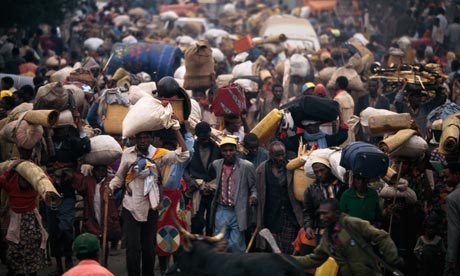 Rwandan refugees in Zaire, now the Democratic Republic of Congo, in 1994. Photograph: Charles Caratini/Sygma/Corbis Today, the United Nations Office of the High Commissioner for Human Rights is publishing a vitally important report cataloguing the atrocities committed in the Democratic Republic of Congo between 1993 and 2003. Those who go through its 500-plus pages cannot fail to be touched by reading of the horrors the Congolese people have suffered and continue to suffer.
Rwandan refugees in Zaire, now the Democratic Republic of Congo, in 1994. Photograph: Charles Caratini/Sygma/Corbis Today, the United Nations Office of the High Commissioner for Human Rights is publishing a vitally important report cataloguing the atrocities committed in the Democratic Republic of Congo between 1993 and 2003. Those who go through its 500-plus pages cannot fail to be touched by reading of the horrors the Congolese people have suffered and continue to suffer.While many of the massacres have been documented previously, this is the first report to comprehensively analyse and compile these horrendous attacks, perpetrated by a variety of armed actors over the course of a decade. The report is a powerful reminder of the gravity of the crimes committed in Congo and of the shocking absence of justice. I know because I was there.
In 1997, I was deputy chief of an investigative team sent by UN secretary-general Kofi Annan to investigate crimes committed in Congo from 1993 to 1997. The worst period was from late 1996 to 1997, when forces supporting Laurent-Desiré Kabila, father of the current Congolese president, attacked Rwandan Hutu refugees as the elder Kabila swept to power with the support of Rwanda. We received detailed reports of mass slaughter, but our attempts to reach massacre sites were repeatedly thwarted by travel bans, "spontaneous" demonstrations and the arrest of one of our investigators. Although we were stuck for months in Kinshasa, the capital, we were nevertheless able to conclude that some of the attacks revealed "the intent to eliminate those Rwandan Hutus who remained" in Congo.
The UN report published today supports our preliminary findings and documents horrific crimes by many other actors in Congo. Fortunately, this time the UN team had full access to the massacre sites and to witnesses. The key question now, as it was when our team delivered its report in 1998, is whether the international community has the political will to take the next step: identifying the killers and bringing them to justice.
In 1998, our team called on the UN to seek justice for the crimes we documented, and Annan told the security council that "those guilty of violations must be brought to book." The council effectively buried our report, however, signaling to all of those competing to control the eastern part of this resource-rich country that there were no holds barred. As the new report documents, a multiplicity of government armies, rag-tag rebel groups and brutal ethnic militias took that signal as a green light to continue to kill, rape and plunder.
Although the new report does not attribute individual responsibility, it does make clear that many of the soldiers who committed the 1996-7 atrocities were under the effective command of Rwandan army officers and that their overall commander was Colonel James Kabarebe, a Rwandan who had become the interim chief of staff of the Congolese armed forces. He was promoted to chief of staff of the Rwandan army several years later, and today is Rwanda's defence minister.
This conclusion is no surprise. Although the United States denied our team crucial intelligence regarding the structure and movement of Rwandan troops, witnesses consistently told us that officers speaking the Rwandan language were present during the killing of unarmed refugees. Even at the time, Rwanda's strongman – now its president, Paul Kagame – boasted that his government planned and led the military campaign, telling the Washington Post that his objectives were to "dismantle" the Hutu refugee camps in Zaire (as the Congo was then called), "destroy the structure" of the Hutu militia units and "deal with" the Hutu extremists.
What were his exact orders? We are not sure, but as the new report notes, the campaign's final massacres, in Mbandaka and Wendji, over 2,000 kilometres west of Rwanda, "were the final stage in the hunt for Hutu refugees that had begun in eastern Zaire, in North and South Kivu, in October 1996". It adds that the deaths of "several tens of thousands", many of whom were killed after the refugee camps had been dismantled, "cannot be attributed to the hazards of war or seen as equating to collateral damage". It found that "the majority of the victims were children, women, elderly people and the sick, who posed no threat to the attacking forces".
The Rwandan government has attempted to discredit the report and to pressure Ban Ki-moon to stop its publication, threatening to pull out of its UN peacekeeping commitments in Darfur and elsewhere. By seeking to quash publication of the report, the Rwandan government is raising further questions about what it may be trying to hide. Kagame's forces played a crucial role in ending the 1994 genocide in Rwanda, but this does not absolve them of scrutiny for crimes they may have committed in the years that followed, both in Rwanda and Congo.
Indeed, the Rwandan government's reaction can only hinder efforts to find a lasting solution to the continuing conflict in Congo. As Annan noted in 1998, one of the root causes of the region's conflicts is "a vicious cycle of violations of human rights and revenge, fuelled by impunity. This cycle has to be brought to an end if lasting peace and stability are to be restored to the region." Twelve years later, it is time to heed these words by identifying and bringing to justice the individuals responsible for these atrocities.


No comments:
Post a Comment